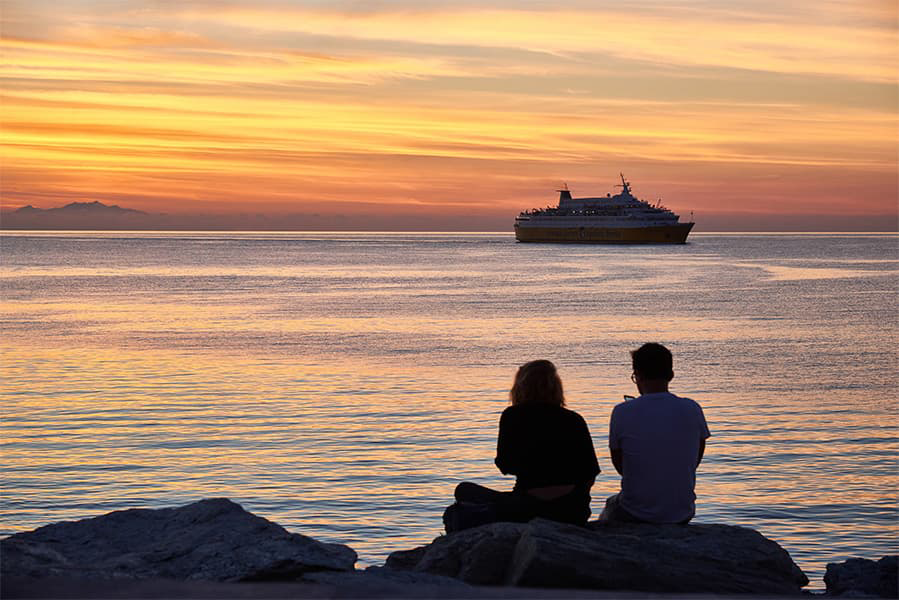Symi – Tilos
Ferries to Dodecanese Islands
Symi – Tilos
Ferries to Dodecanese Islands

2 operators sail this route
The Symi (Simi) Tilos ferry typically departs from Symi (Simi) at around 17:30.
Symi (Simi) Tilos Ferry sail durations on this ferry route can take around 2h 35m. The fastest sailings are approximately 2h 35m. Sailing times can vary, durations often differ between ferry operators and can be impacted by weather conditions.
There is 1 weekly sailing from Symi (Simi) to Tilos provided by Blue Star Ferries & SAOS Ferries. Timetables can change from season to season.
Symi (Simi) Tilos ferry prices typically range between 18.0 €* and 18.0 €*. The average price is typically 18.0 €*. The cheapest Symi (Simi) Tilos ferry prices start from 18.0 €*. The average price for a foot passenger is 18.0 €*.
Pricing will vary depending on number of passengers, vehicle type, route and sailing times. Prices exclude service fees.
The distance between Symi (Simi) to Tilos is approximately 33.9 miles (54.6km) or 29.5 nautical miles.
No, ferry operators currently do not allow cars to travel on sailings between Symi (Simi) and Tilos
Yes, foot passengers can travel with
Pets are allowed on ferries travelling from Symi (Simi) to Tilos with Blue Star Ferries. Please also note that your pet may have to stay in the vehicle during the journey unless the ferry operator supplies pet accommodation.
More routes than anyone else.

Compare fares, times & routes in one place.
Change plans easily with flexi tickets.

Book e-tickets & manage trips in-app.
Live ship tracking & real-time updates.

Top-rated customer support when you need it.
| Symi (Simi) - Tilos Route summary | ||
|---|---|---|
| Departure Country | Greece | |
| Destination Country | Greece | |
| No. of Operators | 2 | |
| Operators | Blue Star Ferries & SAOS Ferries | |
| Average Price | 18 €* | |
| Average Weekly Sailings | 1 | |
| Average Sailing Duration | 2h 35m | |
| First Ferry | 17:30 | |
| Last Ferry | 19:40 | |
| Distance | 29 nautical miles | |
* Prices subject to change, pricing is taken from last 30 days, last updated 2024-11-05.
The Greek island of Symi is one of the Dodecanese Islands and is located around 40 km to the north west of the island of Rhodes and 420 km from the Port of Piraeus. Symi's closest neighbours are the Datca and Bozburun peninsulars of Mugla Province in Turkey. The island's terrain is mainly mountainous and its coastline is made up of either beaches and secluded coves, or rocky cliffs. Located on the north east coast of the island is its main town, also called Symi. The lower town is the area around the harbour, called Yialos, and the upper town is called Horio or Ano Symi. There isn't a great deal to see or do on the island, and this is perhaps where its charm is. Apart from lazing on the beach or swimming in its crystal clear waters the Monastery of the Archangel Panormitis, which is an early 18th century Greek Orthodox monastery built on the coast in the south west of the country, is worth visiting. Overlooking Ano Symi is the Kastro which was built by the Knights of St. John as an expansion of a Byzantine castle on the same site. Quite a bit of the structure remains and there are also signs of an ancient citadel on which two later castles were built.
The Greek island of Tilos is one of the Dodecanese group of islands and lies in the Aegean Sea. Unlike some of its neighbours, Tilos is a quiet island with few residents which as a result has managed to retain its original Greek atmosphere and charm. Those that do live on the island largely live off fishing, some agriculture and the little tourism that does exist. A popular site on the island is the beautiful but abandoned 15th century monastery of Agios Panteleimon, which contains some interesting icons. Also of interest is the Castle of the Knights, where the Knights of St. John were based in the 15th century. Also on the island are a number of other churches including perhaps the best known Church of the Archangel Michael which is in Megalo Chorio. Other popular sites on the island are the Park of Tilos, with its many species of flora and fauna, and the Cave of Charkadio where visitors can see the remains of the dwarf elephants that lived on the island some 45,000 years ago. The fossilised bones where first discovered in the 1970's.